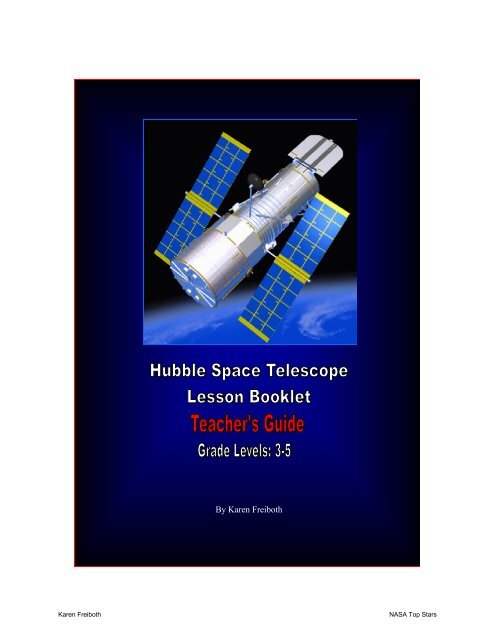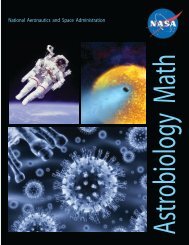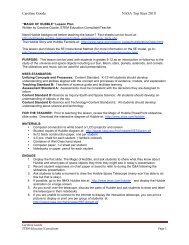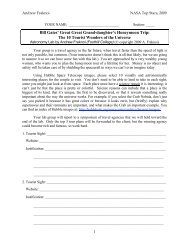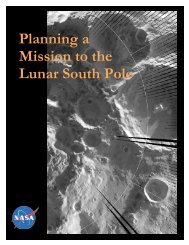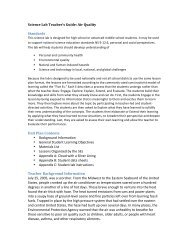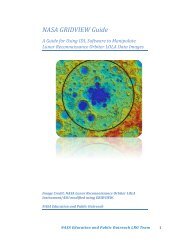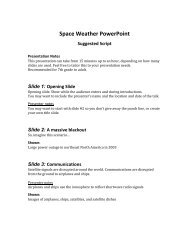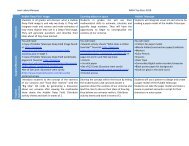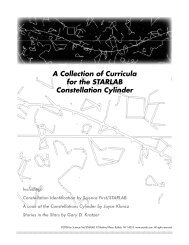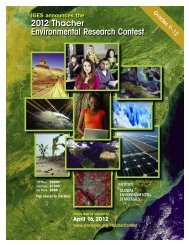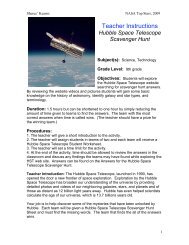Hubble Space Telescope Lesson Booklet Teacher's ... - Top Stars
Hubble Space Telescope Lesson Booklet Teacher's ... - Top Stars
Hubble Space Telescope Lesson Booklet Teacher's ... - Top Stars
Create successful ePaper yourself
Turn your PDF publications into a flip-book with our unique Google optimized e-Paper software.
By Karen Freiboth<br />
Karen Freiboth<br />
NASA <strong>Top</strong> <strong>Stars</strong>
This<br />
<strong>Hubble</strong> <strong>Space</strong> <strong>Telescope</strong><br />
<strong>Lesson</strong> <strong>Booklet</strong><br />
Belongs to:<br />
Student’s Name<br />
Karen Freiboth<br />
NASA <strong>Top</strong> <strong>Stars</strong>
Table of Contents<br />
Edwin P. <strong>Hubble</strong>...........................................................1<br />
Tuning Fork Diagram................................................... 2<br />
<strong>Hubble</strong>’s Galaxies.........................................................3<br />
Identify The Galaxies....................................................4<br />
The <strong>Hubble</strong> <strong>Space</strong> <strong>Telescope</strong>........................................5-6<br />
<strong>Hubble</strong> <strong>Space</strong> <strong>Telescope</strong> Diagram.................................7<br />
How <strong>Hubble</strong> Went to <strong>Space</strong>.......................................... 8<br />
Discovery Crew STS-31................................................9<br />
Positioning <strong>Hubble</strong>........................................................10<br />
HST in <strong>Space</strong>.................................................................11<br />
<strong>Hubble</strong> <strong>Space</strong> <strong>Telescope</strong> Images... ..............................12-13<br />
Make Your Own HST Photo Album.............................14-16<br />
How To Make Your HST Photo Album........................17-22<br />
<strong>Hubble</strong>’s Servicing Missions.........................................23<br />
Questions For Discussion..............................................24-25<br />
Track the HST<br />
<strong>Hubble</strong> Careers<br />
Glossary<br />
Credits & Photo Credits<br />
Karen Freiboth<br />
NASA <strong>Top</strong> <strong>Stars</strong>
Vocabulary Words<br />
Andromeda Galaxy<br />
Astronaut<br />
Astronomer<br />
Astronomy<br />
Atmosphere<br />
Barred Galaxies<br />
Celestial Objects<br />
Collision<br />
Constellation<br />
Diameter<br />
Earth<br />
Edwin Powell <strong>Hubble</strong><br />
Elliptical Galaxies<br />
Expand<br />
Exploration<br />
Galaxy<br />
Goddard <strong>Space</strong> Flight Center<br />
<strong>Hubble</strong> <strong>Space</strong> <strong>Telescope</strong> (HST)<br />
Image<br />
Kilometer<br />
Large Magellanic Cloud<br />
Launch<br />
Light Year<br />
Milky Way<br />
Mph<br />
NASA<br />
Nebula<br />
Orbit<br />
Orbiter<br />
Planet<br />
Reflecting <strong>Telescope</strong><br />
Saturn<br />
<strong>Space</strong> Shuttle<br />
<strong>Space</strong>walk<br />
Spiral Galaxies<br />
Star<br />
STS<br />
<strong>Telescope</strong><br />
Universe<br />
Karen Freiboth<br />
NASA <strong>Top</strong> <strong>Stars</strong>
Objective:<br />
To learn a brief history about Edwin P. <strong>Hubble</strong>.<br />
1<br />
Edwin P. <strong>Hubble</strong><br />
1889 - 1953<br />
On November 20, 1889 Edwin Powell <strong>Hubble</strong> was<br />
born in Marshfield, Missouri. He lived in Missouri for a<br />
short period of time until his family moved to Wheaton, Illinois.<br />
The family moved before <strong>Hubble</strong>’s first birthday.<br />
When <strong>Hubble</strong> grew up, he attended college<br />
and studied law because his father wanted him to. But he<br />
realized that his passion was astronomy. He then decided to<br />
study astronomy and mathematics at the University of<br />
Chicago. In 1910, he earned a bachelor of science degree.<br />
After completing his education, he pursued other interests of<br />
his before eventually returning to the University of Chicago<br />
where he earned a doctorate degree in 1917.<br />
A few years after the completion of his educational<br />
studies, Edwin <strong>Hubble</strong> became a famous American<br />
astronomer. It was in the 1920s when he discovered that<br />
there are many more galaxies that exist outside of our own<br />
Milky Way galaxy. His discovery has forever changed how<br />
the Universe is viewed. On September 28, 1953 Edwin P.<br />
<strong>Hubble</strong> died of a heart attack at the age of 63 years in San<br />
Marino, California.<br />
Karen Freiboth<br />
NASA <strong>Top</strong> <strong>Stars</strong>
2<br />
Objectives:<br />
To be introduced to the <strong>Hubble</strong> Tuning Fork Diagram<br />
To be introduced to <strong>Hubble</strong>’s Classification Scheme.<br />
To learn of <strong>Hubble</strong>’s three types of galaxies.<br />
Tuning Fork Diagram<br />
The <strong>Hubble</strong><br />
Tuning Fork Diagram<br />
In the year 1923, Edwin P. <strong>Hubble</strong> discovered that the<br />
Andromeda Nebula was actually a galaxy. Today, the<br />
Andromeda Nebula is referred to as the Andromeda Galaxy.<br />
Over the next few years, <strong>Hubble</strong> discovered many more<br />
galaxies and by the end of the same decade, <strong>Hubble</strong> found so<br />
many galaxies that he started to compare them to one another.<br />
He then developed a method of classifying the galaxies into<br />
three categories: elliptical galaxies, spiral galaxies, and<br />
barred spiral galaxies. This method is called the <strong>Hubble</strong><br />
Tuning Fork Diagram. The diagram is still used by<br />
scien-tists today, but in an updated version.<br />
Karen Freiboth<br />
NASA <strong>Top</strong> <strong>Stars</strong>
Objective:<br />
To use visual images of <strong>Hubble</strong>’s three types of<br />
galaxies to show the characteristics of each.<br />
3<br />
<strong>Hubble</strong>’s Galaxies<br />
<strong>Hubble</strong>’s Three Types of Galaxies<br />
Elliptical Galaxy<br />
Spiral Galaxy<br />
Barred Spiral Galaxy<br />
Karen Freiboth<br />
NASA <strong>Top</strong> <strong>Stars</strong>
4<br />
Objective:<br />
To use visual images to correctly identify <strong>Hubble</strong>’s<br />
three types of galaxies.<br />
Identify The Galaxies<br />
Directions:<br />
You have just learned how <strong>Hubble</strong> classified galaxies into<br />
three categories. Below are pictures of the three different<br />
types of galaxies that <strong>Hubble</strong> classified. Write the correct<br />
type of galaxy in the blank box next to each picture.<br />
Teacher remind your students that the three types<br />
of galaxies are:<br />
Elliptical Galaxy<br />
Spiral Galaxy<br />
Barred Spiral Galaxy<br />
Answer Key:<br />
Elliptical Galaxy<br />
Answer Key:<br />
Barred Spiral Galaxy<br />
Answer Key:<br />
Spiral Galaxy<br />
Karen Freiboth<br />
NASA <strong>Top</strong> <strong>Stars</strong>
Objective:<br />
To use a visual image to introduce the <strong>Hubble</strong><br />
<strong>Space</strong> <strong>Telescope</strong>.<br />
5<br />
The <strong>Hubble</strong> <strong>Space</strong> <strong>Telescope</strong><br />
HST<br />
in <strong>Space</strong><br />
Karen Freiboth<br />
NASA <strong>Top</strong> <strong>Stars</strong>
6<br />
Objective:<br />
To introduce the HST as an orbiting space telescope.<br />
The <strong>Hubble</strong> <strong>Space</strong> <strong>Telescope</strong><br />
NASA’s <strong>Hubble</strong> <strong>Space</strong> <strong>Telescope</strong> (HST) is a very large<br />
orbiting telescope named after Edwin P. <strong>Hubble</strong>. NASA’s<br />
Goddard <strong>Space</strong> Flight Center controls the telescope by using<br />
radio commands. The telescope is used by astronomers and other<br />
scientists to thoroughly search and explore the Universe. The<br />
HST is a very powerful reflecting telescope. Its light-gathering<br />
mirror is 94 inches in diameter. Because the <strong>Hubble</strong> is so<br />
powerful and it is above the planet Earth’s atmosphere, it<br />
produces images that are more detailed than images obtained by<br />
most other telescopes.<br />
The <strong>Hubble</strong> <strong>Space</strong> <strong>Telescope</strong> is orbiting in space<br />
approximately 360 miles above the surface of the Earth. Every 97<br />
minutes, it completes one orbit around the Earth. It is circling<br />
around the Earth at a speed of 17,500 mph., taking pictures of<br />
planets, stars, galaxies, and other celestial objects. Since its<br />
launch in 1990, the HST has taken billions of photo images. The<br />
images taken by the telescope are transmitted by radio to<br />
astronomers here on Earth. The data collected by <strong>Hubble</strong> has<br />
greatly helped astronomers and the entire scientific community in<br />
gaining a better understanding of the Universe.<br />
Karen Freiboth<br />
NASA <strong>Top</strong> <strong>Stars</strong>
Objective:<br />
To use a visual diagram of the HST to show the<br />
various parts that the HST is built with.<br />
7<br />
<strong>Hubble</strong> <strong>Space</strong> <strong>Telescope</strong> Diagram<br />
This is a diagram of the <strong>Hubble</strong> <strong>Space</strong><br />
<strong>Telescope</strong>. The diagram shows the various parts<br />
that the <strong>Hubble</strong> <strong>Space</strong> <strong>Telescope</strong> is built with.<br />
solar panels<br />
radio antenna<br />
secondary<br />
mirror<br />
light shield<br />
aperture<br />
door<br />
electronic<br />
boxes<br />
baffle<br />
Sun<br />
sensor<br />
Primary<br />
mirror<br />
solar panels<br />
instrument<br />
module<br />
aft shroud<br />
guidance<br />
sensors<br />
radio antenna<br />
Karen Freiboth<br />
NASA <strong>Top</strong> <strong>Stars</strong>
8<br />
Objectives:<br />
To learn about NASA’s <strong>Space</strong> Shuttle Discovery<br />
STS-31 crew.<br />
To use a visual image to learn how the HST went to<br />
space.<br />
How <strong>Hubble</strong> Went to <strong>Space</strong><br />
NASA’s<br />
<strong>Space</strong> Shuttle Discovery STS-31<br />
On April 24, 1990 the <strong>Hubble</strong> <strong>Space</strong> <strong>Telescope</strong><br />
rode into space inside of NASA’s <strong>Space</strong><br />
Shuttle Discovery. The Discovery launch was a<br />
spectacular sight in the sky and it was the beginning<br />
of the <strong>Hubble</strong> <strong>Space</strong> <strong>Telescope</strong>’s mission.<br />
Karen Freiboth<br />
NASA <strong>Top</strong> <strong>Stars</strong>
Objective:<br />
To use a visual image to learn about the NASA<br />
STS-31 astronauts who rode into space with the<br />
HST.<br />
9<br />
Discovery Crew STS-31<br />
NASA’s<br />
<strong>Space</strong> Shuttle Discovery STS-31<br />
Astronauts<br />
Charles F. Bolden, Pilot<br />
Steven A. Hawley, Mission Specialist<br />
Loren J. Shriver, Commander<br />
Bruce McCandless, Mission Specialist<br />
Kathryn D. Sullivan, Mission Specialist<br />
Karen Freiboth<br />
NASA <strong>Top</strong> <strong>Stars</strong>
10<br />
Objective:<br />
To use a visual image to show how the STS-31<br />
astronauts positioned the HST in space.<br />
Positioning <strong>Hubble</strong><br />
<strong>Hubble</strong> Just Before<br />
Being Placed into <strong>Space</strong><br />
The <strong>Hubble</strong> <strong>Space</strong> <strong>Telescope</strong><br />
As it was Being Positioned in <strong>Space</strong><br />
This picture was taken on April 25, 1990 from<br />
an inside window of the <strong>Space</strong> Shuttle Discovery<br />
STS-31; it shows the Discovery orbiter as it is<br />
placing the <strong>Hubble</strong> <strong>Space</strong> <strong>Telescope</strong> into orbit. It took<br />
years of study and a lot of hard work for each<br />
astronaut to perform this task, but they had a great time<br />
doing it because science is fun!<br />
Karen Freiboth<br />
NASA <strong>Top</strong> <strong>Stars</strong>
Objective:<br />
To use a visual image to show how the HST<br />
looked in space when the STS-31 astronauts positioned<br />
and released the HST in space for its first<br />
time.<br />
HST in <strong>Space</strong><br />
11<br />
<strong>Hubble</strong>’s First Time in <strong>Space</strong><br />
The <strong>Hubble</strong> <strong>Space</strong> <strong>Telescope</strong><br />
After it was Positioned and Released<br />
into <strong>Space</strong> to Begin its Mission<br />
On April 25, 1990 the <strong>Space</strong> Shuttle Discovery<br />
STS-31 crew positioned the <strong>Hubble</strong> <strong>Space</strong><br />
<strong>Telescope</strong> into space. This picture shows how the<br />
<strong>Hubble</strong> looked after it was placed into orbit directly<br />
above the Earth’s atmosphere. This was a new<br />
beginning for space exploration and discovery with<br />
the release of the <strong>Hubble</strong> <strong>Space</strong> <strong>Telescope</strong> from the<br />
Discovery orbiter.<br />
Karen Freiboth<br />
NASA <strong>Top</strong> <strong>Stars</strong>
12<br />
Objective:<br />
To use visual images to learn about the HST image<br />
Betelgeuse Red Supergiant Star and the HST image<br />
of the Planet Saturn.<br />
<strong>Hubble</strong> <strong>Space</strong> <strong>Telescope</strong> Images<br />
Amazing Images Taken<br />
By The <strong>Hubble</strong> <strong>Space</strong> <strong>Telescope</strong><br />
Betelgeuse<br />
Red Supergiant Star<br />
The above image is the very first direct photograph<br />
of a star that the <strong>Hubble</strong> <strong>Space</strong> <strong>Telescope</strong> captured.<br />
This is a red supergiant star referred to as Alpha<br />
Orionis or Betelgeuse.<br />
The Planet Saturn<br />
The <strong>Hubble</strong> <strong>Space</strong> <strong>Telescope</strong>’s<br />
Beautiful Image of the Planet Saturn<br />
Karen Freiboth<br />
NASA <strong>Top</strong> <strong>Stars</strong>
Objective:<br />
To use visual images to learn about the HST<br />
image of two spiral galaxies colliding in space and<br />
the HST image of the Large Magellanic Cloud.<br />
13<br />
<strong>Hubble</strong> <strong>Space</strong> <strong>Telescope</strong> Images<br />
Two Spiral Galaxies<br />
Colliding in <strong>Space</strong><br />
The <strong>Hubble</strong> captured this incredible picture of a<br />
collision in space. The two colliding spiral galaxies are<br />
part of the Hercules Galaxy Cluster, which is in the<br />
constellation of Hercules.<br />
A Fantastic<br />
Celestial Display<br />
This remarkable <strong>Hubble</strong> image, which looks like<br />
fireworks, is actually pieces left over from a star that<br />
exploded in a galaxy nearby called the Large Magellanic<br />
Cloud.<br />
Karen Freiboth<br />
NASA <strong>Top</strong> <strong>Stars</strong>
14<br />
Objectives:<br />
To use technology and photo images taken by the<br />
HST to learn about celestial objects in space.<br />
To provide a hands-on learning experience using<br />
HST images.<br />
Make Your Own HST Photo Album<br />
Important<br />
Pre-Project Teacher Preparations<br />
Are Listed on Pages 15 & 16<br />
Introduce the HST Photo Album to students as a<br />
hands-on HST learning project.<br />
My Very Own<br />
<strong>Hubble</strong> <strong>Space</strong> <strong>Telescope</strong><br />
Photo Album<br />
Karen Freiboth<br />
NASA <strong>Top</strong> <strong>Stars</strong>
This page contains a list of the materials you will<br />
need to make a teacher display model of the My<br />
Very Own HST Photo Album.<br />
15<br />
Make Your Own HST Photo Album<br />
Make a display model of the HST Photo Album<br />
before your students begin this project.<br />
Use your model as a display for your students.<br />
Your model will provide your students with a<br />
visual understanding of the project.<br />
Materials Needed to Make a Display Model:<br />
Heavy Black Construction Paper (3 Sheets)<br />
White Multiuse Paper for printers<br />
Ball of Red Yarn (cut [3] 6 in. pieces)<br />
Glue Stick<br />
Scissors<br />
Ruler (12 In.)<br />
Hole-Puncher<br />
1 Photo Album Cover Sheet<br />
5 <strong>Hubble</strong> Description Sheets<br />
5 <strong>Hubble</strong> Images (Size 3.5 in. X 5in.)<br />
Computer<br />
Color Printer<br />
Internet access to the following website:<br />
http://hubblesite.org/gallery/printshop/<br />
Karen Freiboth<br />
NASA <strong>Top</strong> <strong>Stars</strong>
16<br />
Pre-make all of your students’ HST photo album<br />
pages. This step will eliminate paper waste.<br />
Pre-cut all of your students’ strips of yarn. This<br />
step will save classroom minutes.<br />
Make Your Own HST Photo Album<br />
How to Make My Students’<br />
My Very Own HST photo album pages<br />
Step: 1<br />
<br />
<br />
<br />
Take 3 Pieces of black construction paper<br />
Fold all 3 pieces of paper in half horizontally<br />
Using your hole puncher, make 3 holes on the<br />
left side of the paper<br />
Repeat these steps for each student.<br />
Step: 2<br />
Use your ruler to measure and then cut 3 (6 in.)<br />
pieces of yarn<br />
(Each student needs 3 pieces of yarn)<br />
Now, distribute the materials listed<br />
above to your students and begin the project.<br />
Karen Freiboth<br />
NASA <strong>Top</strong> <strong>Stars</strong>
Guide students to a computer to gain access to<br />
HUBBLESITE’S Astronomy Printshop.<br />
Distribute the My Very Own HST Photo Album<br />
Student Selection Packets (1 per student).<br />
Distribute Photo Album Cover Sheets (I per student)<br />
Distribute <strong>Hubble</strong> Images Description Sheets (5 per student)<br />
17<br />
How to Make Your Own HST Photo Album<br />
Ask Students to Visit the Following Website<br />
to learn about 32 images<br />
taken by the HST:<br />
HUBBLESITE<br />
Astronomy Printshop<br />
http://hubblesite.org/gallery/printshop/<br />
After your students visit the<br />
HUBBLESITE Astronomy Printshop,<br />
distribute the HST My Very Own Photo Album<br />
<strong>Hubble</strong> Images Student Selection Packets<br />
(1 per student).<br />
NEXT<br />
Ask Students to Complete their Student <strong>Hubble</strong> Images<br />
Selections order Forms (Located at the end of<br />
each student’s <strong>Hubble</strong> Images Selection Packet).<br />
Once you have all of your students’ <strong>Hubble</strong> Images<br />
selections forms collected, use your My Students<br />
<strong>Hubble</strong> Images Selection Order Form Packet<br />
to fill each student’s <strong>Hubble</strong> Images order;<br />
Return each students’ 5 selected <strong>Hubble</strong> Images<br />
Distribute Photo Album Cover Sheets<br />
(1 per Student)<br />
Distribute <strong>Hubble</strong> Images Description Sheets<br />
(5 per Student)<br />
Karen Freiboth<br />
NASA <strong>Top</strong> <strong>Stars</strong>
18<br />
The list below contains all of the materials<br />
your students will need to complete their own<br />
individual HST Photo Album.<br />
How to Make Your Own HST Photo Album<br />
Materials Needed for Each Student:<br />
1 Photo Album Cover Sheet<br />
5 <strong>Hubble</strong> Image Description Sheets<br />
5 <strong>Hubble</strong> <strong>Space</strong> <strong>Telescope</strong> Images (Size 3.5 in. X<br />
5 in.)<br />
(3) 6 in. Pieces of Red Yarn<br />
Photo Album Pages<br />
1 Glue Stick<br />
1 Scissors<br />
Pencil<br />
1 <strong>Hubble</strong> Images Student Selection Packet<br />
Computer<br />
Internet Access to the Following Web site:<br />
HUBBLESITE<br />
Astronomy Printshop<br />
http://hubblesite.org/gallery/printshop/<br />
Karen Freiboth<br />
NASA <strong>Top</strong> <strong>Stars</strong>
Begin the HST Photo Album Project by<br />
distributing the photo album pages and<br />
yarn to each student.<br />
19<br />
How to Make Your Own HST Photo Album<br />
Ask students to complete the step listed below.<br />
Step: 1<br />
Ask Students to insert one piece of yarn into the top<br />
hole of the photo album pages, then ask them to tie a<br />
loose double knot (Do not make the knot tight because<br />
a tight knot will prevent the pages from turning).<br />
Ask Students to Repeat this step with each piece of<br />
yarn until all three pieces have been inserted and<br />
loosely tied as shown in the picture below.<br />
Karen Freiboth<br />
NASA <strong>Top</strong> <strong>Stars</strong>
20<br />
Assist students in properly gluing their photo<br />
album cover sheet onto their HST photo album<br />
cover.<br />
How to Make Your Own HST Photo Album<br />
Ask students to complete the step listed below.<br />
Step: 2<br />
Ask Students to:<br />
Print their names onto their photo album cover<br />
sheets<br />
Cut out their photo sheets (Cut along the red outline)<br />
Glue their cover sheet onto the front of the photo<br />
album, as shown in the picture below.<br />
Karen Freiboth<br />
NASA <strong>Top</strong> <strong>Stars</strong>
If necessary, assist students with cutting and<br />
preparation of the HST photo album materials<br />
21<br />
How to Make Your Own HST Photo Album<br />
Step: 3<br />
Ask Students to:<br />
Use a pencil to write in the information on each<br />
of their 5 <strong>Hubble</strong> Images Description worksheets.<br />
Step 4:<br />
After completing the written work on each of the 5<br />
<strong>Hubble</strong> Images Description worksheets, Ask Students<br />
to:<br />
<br />
<br />
Cut out their 5 <strong>Hubble</strong> Images (Instruct Students<br />
to cut along the red outline of each worksheet)<br />
Cut out their 5 <strong>Hubble</strong> Images<br />
Karen Freiboth<br />
NASA <strong>Top</strong> <strong>Stars</strong>
22<br />
The completed HST photo album should like<br />
the image shown below.<br />
How to Make Your Own HST Photo Album<br />
Final Step:<br />
Ask Students to glue each of their <strong>Hubble</strong> images<br />
onto the left hand pages of their photo albums.<br />
Completed HST Photo Album<br />
Ask students to glue each of their completed <strong>Hubble</strong><br />
Images description sheets onto the right side of their<br />
photo album.<br />
NOTE: Make sure that each student matches and<br />
glues the correct <strong>Hubble</strong> image with its correct <strong>Hubble</strong><br />
images description sheet.<br />
AND<br />
Ask students to mark the back of each <strong>Hubble</strong> image<br />
with an a symbol (such as an arrow pointing up) to<br />
indicate the correct direction of the image. This will<br />
ensure that each image is properly positioned and<br />
glued into place in the photo album.<br />
Karen Freiboth<br />
NASA <strong>Top</strong> <strong>Stars</strong>
Objective:<br />
To gain knowledge of all of the <strong>Hubble</strong> <strong>Space</strong><br />
<strong>Telescope</strong>’s servicing missions.<br />
23<br />
<strong>Hubble</strong>’s Servicing Missions<br />
After NASA’s <strong>Hubble</strong> <strong>Space</strong> <strong>Telescope</strong> was first<br />
released into space in 1990, NASA astronauts have<br />
returned to the <strong>Hubble</strong> several times to do<br />
maintenance and repairs. The box below lists all of<br />
<strong>Hubble</strong>’s Servicing missions:<br />
<strong>Hubble</strong> Servicing Mission 1 (STS-61)<br />
<strong>Space</strong> Shuttle Endeavour<br />
December 1993<br />
<strong>Hubble</strong> Servicing Mission 2 (STS-82)<br />
<strong>Space</strong> Shuttle Discovery<br />
February 1997<br />
<strong>Hubble</strong> Servicing Mission 3A (STS-103)<br />
<strong>Space</strong> Shuttle Discovery<br />
December 19, 1999<br />
<strong>Hubble</strong> Servicing Mission 3B (STS-109)<br />
<strong>Space</strong> Shuttle Columbia<br />
March 1, 2002<br />
<strong>Hubble</strong> Servicing Mission 4 (STS-125)<br />
<strong>Space</strong> Shuttle Atlantis<br />
May 11, 2009<br />
Karen Freiboth<br />
NASA <strong>Top</strong> <strong>Stars</strong>
24<br />
Objective:<br />
To engage students in a whole-group class<br />
discussion of material from this lesson booklet.<br />
Questions For Discussion<br />
1) What is astronomy<br />
The study of stars, planets, and other objects in space<br />
2) What is an astronomer and what kind of science does an<br />
astronomer study<br />
A scientist who observes and studies planets, stars, galaxies,<br />
and other celestial objects<br />
3) Who was Edwin P. <strong>Hubble</strong> and why is he important to the<br />
study of astronomy<br />
A famous American astronomer who discovered that there are<br />
other galaxies that exist outside of the Milky Way and that<br />
the Universe of galaxies is expanding.<br />
4) How many types of galaxies did Edwin <strong>Hubble</strong> identify and<br />
what are the names of the galaxies<br />
Three types of galaxies: Spiral Galaxies, Elliptical Galaxies<br />
and Barred Spiral Galaxies.<br />
5) What is the <strong>Hubble</strong> <strong>Space</strong> <strong>Telescope</strong> and who is it named<br />
after<br />
An orbiting <strong>Space</strong> <strong>Telescope</strong><br />
Edwin P. <strong>Hubble</strong><br />
Karen Freiboth<br />
NASA <strong>Top</strong> <strong>Stars</strong>
Objective:<br />
To engage students in a whole-group class<br />
discussion of material from this lesson booklet.<br />
25<br />
Questions For Discussion<br />
6) Where is the HST and how did it get there<br />
In orbit above the Earth’s surface.<br />
Launched aboard the <strong>Space</strong> Shuttle Discovery STS-31 and<br />
positioned and Released into <strong>Space</strong><br />
by the crew of the <strong>Space</strong> Shuttle Discovery STS-31<br />
7) What does the HST do<br />
Takes images of stars, planets, galaxies and celestial objects<br />
in space for scientific study<br />
8) How do you think Edwin <strong>Hubble</strong> would feel about the HST<br />
Answers will vary<br />
9) Every 97 minutes the <strong>Hubble</strong> <strong>Space</strong> <strong>Telescope</strong> completes one<br />
orbit around the Earth. How many complete orbits around<br />
the Earth does the HST make each day (Remember: there<br />
are 24 hours in a day)<br />
24 × 60 = 1440<br />
1440 ÷ 97 = 14.8 = 14 Complete Orbits<br />
10) The <strong>Hubble</strong> <strong>Space</strong> <strong>Telescope</strong> circles around the Earth at a<br />
speed of 17,500 mph (or, if using metric system, 28,163.52<br />
kph.) How many miles (or kilometers) does the HST<br />
travel in one day<br />
(Remember: there are 24 hours in a day)<br />
English System Answer<br />
17,500 mph × 24 = 420,000 miles<br />
Metric System Answer<br />
28,163.52 kph × 24 = 675,924.48 kilometers<br />
Karen Freiboth<br />
NASA <strong>Top</strong> <strong>Stars</strong>
Objective:<br />
To use technology to track the HST.<br />
Track the HST<br />
You can track the <strong>Hubble</strong> <strong>Space</strong><br />
<strong>Telescope</strong> by using a computer and the internet.<br />
To see where the <strong>Hubble</strong> <strong>Space</strong> <strong>Telescope</strong> is at any<br />
time of the day or night, visit one of the following<br />
Web sites listed below:<br />
HUBBLESITE<br />
THE TELESCOPE<br />
Where’s <strong>Hubble</strong> Now....<br />
http://hubblesite.org/the_telescope/<br />
where.a.s_hubble_now/<br />
For Basic <strong>Hubble</strong> Tracking<br />
Visit This Web site:<br />
http://hubblesite.org/the_telescope/<br />
where.a.s_hubble_now/basic_version.php<br />
For More Advanced <strong>Hubble</strong> Tracking<br />
Visit This Web site:<br />
http://hubblesite.org/the_telescope/<br />
where.a.s_hubble_now/advanced_version.php<br />
Karen Freiboth<br />
NASA <strong>Top</strong> <strong>Stars</strong>
Objective:<br />
To introduce students to NASA web sites that<br />
teach about <strong>Hubble</strong> <strong>Space</strong> <strong>Telescope</strong> careers.<br />
<strong>Hubble</strong> Careers<br />
To Learn About Some of the<br />
Fun and Exciting <strong>Hubble</strong> Careers<br />
Please Visit the Following Web site:<br />
<strong>Hubble</strong> Careers in Action<br />
http://www.nasa.gov/audience/foreducators/<br />
hubble-careers.html<br />
Karen Freiboth<br />
NASA <strong>Top</strong> <strong>Stars</strong>
Objective:<br />
To introduce students to NASA web sites that<br />
teach about <strong>Hubble</strong> <strong>Space</strong> <strong>Telescope</strong> careers.<br />
<strong>Hubble</strong> Careers<br />
Goddard Engineers and Divers<br />
Multi-Task for <strong>Hubble</strong><br />
Did you ever wonder how NASA astronauts<br />
prepare for <strong>Hubble</strong> <strong>Space</strong> <strong>Telescope</strong> servicing<br />
missions<br />
Pictured above are <strong>Hubble</strong> Carrier<br />
Manager Mark Hubbard of Goddard (left)<br />
and EVA and Crew Systems Engineer<br />
Steve Schneider of SGT, Inc., prepare for a<br />
two-hour scuba run in the Neutral Buoyancy<br />
Lab water tank. Hubbard and Schneider's dive<br />
is part of preparations for <strong>Hubble</strong> Servicing<br />
Mission 4.<br />
To learn more<br />
please visit this website:<br />
http://www.nasa.gov/mission_pages/<br />
hubble/servicing/series/hst_divers.html<br />
Karen Freiboth<br />
NASA <strong>Top</strong> <strong>Stars</strong>
Objective:<br />
To introduce students to NASA web sites that<br />
teach about <strong>Hubble</strong> <strong>Space</strong> <strong>Telescope</strong> careers.<br />
<strong>Hubble</strong> Careers<br />
Thermal Blanket Fabricators<br />
Learn why the <strong>Hubble</strong> needs thermal<br />
blankets and what skills and materials are<br />
needed to make them.<br />
In this picture Goddard engineer Ben<br />
Reed studies a portion of a multi-layer<br />
blanket from <strong>Hubble</strong>, brought back to Earth<br />
after Servicing Mission 3A in 1999.<br />
To learn more<br />
please visit this website:<br />
http://www.nasa.gov/mission_pages/<br />
hubble/servicing/series/hst_blankets.html<br />
Karen Freiboth<br />
NASA <strong>Top</strong> <strong>Stars</strong>
Objective:<br />
To introduce students to NASA web sites that<br />
teach about <strong>Hubble</strong> <strong>Space</strong> <strong>Telescope</strong> careers.<br />
<strong>Hubble</strong> Careers<br />
Flight Controllers<br />
in the <strong>Hubble</strong> Operations Center<br />
The <strong>Hubble</strong> would not be able to do what it does<br />
without the help of a small group of dedicated engineers<br />
and technicians at NASA’s Goddard <strong>Space</strong> Flight Center<br />
in Greenbelt, Md.<br />
This picture shows engineers at Goddard's<br />
<strong>Space</strong> <strong>Telescope</strong> Operations Control<br />
Center monitoring the <strong>Hubble</strong> <strong>Space</strong> <strong>Telescope</strong><br />
around the clock.<br />
To learn more<br />
please visit this website:<br />
http://www.nasa.gov/mission_pages/<br />
hubble/servicing/series/stocc.html<br />
Karen Freiboth<br />
NASA <strong>Top</strong> <strong>Stars</strong>
Objective:<br />
To introduce students to NASA web sites that<br />
teach about <strong>Hubble</strong> <strong>Space</strong> <strong>Telescope</strong> careers.<br />
<strong>Hubble</strong> Careers<br />
Specialized Tool Developers<br />
A team at NASA's Goddard <strong>Space</strong> Flight<br />
Center designs and builds the special tools and aids<br />
astronauts need when they service the <strong>Hubble</strong> <strong>Space</strong><br />
<strong>Telescope</strong>.<br />
Pictured above astronauts practice<br />
installing <strong>Hubble</strong>’s new imaging camera,<br />
the WFC3, using the instrument’s handling<br />
aid. This crew aid will help control the 1,000-<br />
lb. instrument during on-orbit installation of<br />
the camera during Servicing Mission 4.<br />
To learn more<br />
please visit this website:<br />
http://www.nasa.gov/mission_pages/<br />
hubble/servicing/series/stocc.html<br />
Karen Freiboth<br />
NASA <strong>Top</strong> <strong>Stars</strong>
Glossary<br />
Karen Freiboth<br />
NASA <strong>Top</strong> <strong>Stars</strong>
Andromeda Galaxy<br />
Located 2.5 million light-years away, the Andromeda is<br />
our largest nearby galactic neighbor.<br />
Astronaut<br />
A person trained to travel and work in space.<br />
Astronomer<br />
A scientist who observes and studies planets, stars, and<br />
galaxies.<br />
Astronomy<br />
The study of stars, planets, and other objects in space.<br />
Atmosphere<br />
The layers of gases that surround a star, like our Sun, or<br />
a planet, like our Earth.<br />
Barred Spiral Galaxies<br />
Spiral galaxies whose central regions are in the shape of<br />
bars at the ends of which the spiral arms begin. About<br />
one half of all spiral galaxies are barred spiral.<br />
Celestial Objects<br />
Objects in space beyond the Earth.<br />
Collision<br />
A crash or forceful joining together.<br />
Constellation<br />
A named pattern of stars in the sky.<br />
Diameter<br />
The size of a circle (or circular cross-section) based on<br />
the length of the longest straight line that goes through<br />
the center of the circle.<br />
Karen Freiboth<br />
NASA <strong>Top</strong> <strong>Stars</strong>
Earth<br />
The third planet from the sun.<br />
Edwin Powell <strong>Hubble</strong><br />
A famous American astronomer.<br />
Elliptical Galaxy<br />
A collection of millions to billions of stars in the form of<br />
a dense swarm.<br />
Expand<br />
To make larger.<br />
Exploration<br />
The act of looking into or studying something unknown.<br />
Galaxy<br />
A self-gravitating system of stars, gas, dust, planetary<br />
systems, and other matter in motion about its center of<br />
mass. Galaxies are the most visible components of the<br />
larger Universe.<br />
Goddard <strong>Space</strong> Flight Center (GSFC)<br />
NASA’s flight control center in Greenbelt, Maryland,<br />
which receives data from orbiting observatories such as<br />
the <strong>Hubble</strong> <strong>Space</strong> <strong>Telescope</strong> (HST). HST digital data are<br />
then relayed to the <strong>Space</strong> <strong>Telescope</strong> Science Institute in<br />
Baltimore, Maryland, where they are interpreted into pictures.<br />
Goddard also conducts scientific investigations,<br />
develops and operates space systems, and works toward<br />
the advancement of space science technologies.<br />
<strong>Hubble</strong> <strong>Space</strong> <strong>Telescope</strong> (HST)<br />
A large telescope placed in orbit above Earth that takes<br />
pictures of objects in space.<br />
Karen Freiboth<br />
NASA <strong>Top</strong> <strong>Stars</strong>
Image<br />
In astronomy, it is a picture of some part of the sky.<br />
Kilometer<br />
1,000 meters. A kilometer equals 0.6214 miles.<br />
Large Magellanic Cloud<br />
The larger of two small galaxies orbiting nearby our<br />
Milky Way galaxy.<br />
Launch<br />
To send a rocket from Earth.<br />
Light Year<br />
The distance light travels in a year, about 10 trillion kilometers,<br />
or 6 trillion miles.<br />
Milky Way<br />
The galaxy which includes the sun and Earth.<br />
Mph<br />
Miles per hour.<br />
NASA<br />
The NATIONAL AERONAUTICS AND SPACE<br />
ADMINISTRATION which is in charge of all public<br />
space programs of the United States.<br />
Nebula, plural: nebulae<br />
A low density cloud of gas and dust; galaxies were once<br />
thought to be nebulae but are now recognized as much<br />
larger systems of stars, nebulae, planetary systems and<br />
other matter.<br />
Orbit<br />
The path followed by a moon, planet or artificial satellite<br />
as it travels around another body in space.<br />
Karen Freiboth<br />
NASA <strong>Top</strong> <strong>Stars</strong>
Orbiter<br />
The part of the space shuttle that looks like an airplane,<br />
flies into space and back down again, carrying people<br />
and equipment.<br />
Planet<br />
A body that orbits a star in a solar system, and which<br />
shines only by reflected light.<br />
Reflecting <strong>Telescope</strong><br />
<strong>Telescope</strong> that uses mirrors to collect and focus light<br />
from a celestial object onto a detector for recording or<br />
into an eyepiece for viewing.<br />
Saturn<br />
Sixth planet from the sun noted for its bright system of<br />
rings.<br />
<strong>Space</strong> Shuttle<br />
A reusable spacecraft designed to take people and cargo<br />
between Earth and space. It is made up of the external<br />
tank, two solid rocket boosters, and the orbiter with the<br />
three space shuttle main engines.<br />
<strong>Space</strong>walk or Extravehicular Activity (EVA)<br />
Outside the spacecraft; activity in space conducted by<br />
suited astronauts.<br />
Spiral Galaxy<br />
A galaxy that is shaped like a disk with a bulge in the<br />
center. The disk resembles a pinwheel, with bright spiral<br />
arms that coil out from the center bulge.<br />
Star<br />
A large ball of gas that creates and emits its own radiation.<br />
Karen Freiboth<br />
NASA <strong>Top</strong> <strong>Stars</strong>
STS<br />
<strong>Space</strong> Transportation System (NASA’s name for the<br />
overall <strong>Space</strong> Shuttle Program. Part of the mission name:<br />
STS-125 was the 125th <strong>Space</strong> Shuttle mission.)<br />
<strong>Telescope</strong><br />
A device that creates a larger and brighter image of a far<br />
away object.<br />
Universe<br />
The huge space which contains all of the matter and<br />
energy in existence.<br />
Karen Freiboth<br />
NASA <strong>Top</strong> <strong>Stars</strong>
Credits<br />
&<br />
Photo Credits<br />
Karen Freiboth<br />
NASA <strong>Top</strong> <strong>Stars</strong>
HUBBLESITE<br />
Astronomy Printshop<br />
http://hubblesite.org/gallery/printshop/<br />
HUBBLESITE<br />
Reference DESK<br />
Glossary<br />
http://hubblesite.org/reference_desk/glossary/<br />
HUBBLESITE<br />
Reference DESK<br />
Glossary<br />
<strong>Space</strong> <strong>Telescope</strong> Science Institute (STScI)<br />
http://hubblesite.org/reference_desk/glossary/<br />
http://hubblesite.org/reference_desk/glossary/index.phprange=qs<br />
HUBBLESITE<br />
THE TELESCOPE<br />
Team <strong>Hubble</strong>: Servicing Missions<br />
NASA<br />
<strong>Space</strong> <strong>Telescope</strong> Science Institute (STScI)<br />
http://hubblesite.org/the_telescope/team_hubble/<br />
servicing_missions.php<br />
http://hubblesite.org/the_telescope/team_hubble/<br />
servicing_missions.php#sm4<br />
HUBBLESITE<br />
Reference DESK<br />
Glossary<br />
http://hubblesite.org/reference_desk/glossary/<br />
Karen Freiboth<br />
NASA <strong>Top</strong> <strong>Stars</strong>
HUBBLESITE<br />
Reference DESK<br />
Glossary<br />
NASA<br />
<strong>Space</strong> <strong>Telescope</strong> Science Institute (STScI)<br />
http://hubblesite.org/reference_desk/glossary/<br />
http://hubblesite.org/reference_desk/glossary/index.phprange=qs<br />
HUBBLESITE<br />
THE TELESCOPE<br />
Team <strong>Hubble</strong>: Servicing Missions<br />
NASA<br />
<strong>Space</strong> <strong>Telescope</strong> Science Institute (STScI)<br />
http://hubblesite.org/the_telescope/team_hubble/<br />
servicing_missions.php<br />
http://hubblesite.org/the_telescope/team_hubble/<br />
servicing_missions.php#sm4<br />
NASA<br />
Aerospace Science and Technology Dictionary<br />
http://www.hq.nasa.gov/office/hqlibrary/aerospacedictionary/<br />
NASA<br />
Amazing Andromeda Galaxy<br />
November 30, 2007<br />
http://www.nasa.gov/vision/universe/starsgalaxies/spitzerf-<br />
20061003.html<br />
NASA<br />
GODDARD SPACE FLIGHT CENTER<br />
Scientific Visualization Studio<br />
SVS Keyword Dictionary<br />
Cargo Bay<br />
http://svs.gsfc.nasa.gov/search/Keyword/SVS.html<br />
Karen Freiboth<br />
NASA <strong>Top</strong> <strong>Stars</strong>
NASA<br />
GODDARD SPACE FLIGHT CENTER<br />
THE HUBBLE PROJECT<br />
SERVICING MISSION 3B<br />
Glossary<br />
October 24, 2005<br />
http://sm3b.gsfc.nasa.gov/glossary.html<br />
NASA<br />
World Book at NASA<br />
Brecher, Kenneth. "Galaxy." World Book Online Reference<br />
Center. 2005. World Book, Inc.<br />
http://www.worldbookonline.com/wb/Articleid=ar215080<br />
http://www.nasa.gov/worldbook/galaxy_worldbook.html<br />
NASA<br />
Jet Propulsion Laboratory<br />
California Institute of Technology<br />
Basics of <strong>Space</strong> Flight<br />
Glossary<br />
http://www2.jpl.nasa.gov/basics/bsfgloss.htm#T<br />
NASA<br />
Jet Propulsion Laboratory<br />
California Institute of Technology<br />
DAWN DICTIONARY<br />
Vocabulary<br />
Dawn Dictionary<br />
http://dawn.jpl.nasa.gov/dictionary/index.asp<br />
NASA<br />
NASA Dictionary<br />
Picture Dictionary<br />
http://www.nasa.gov/audience/forstudents/5-8/index.html<br />
http://www.nasa.gov/audience/forstudents/k-4/dictionary/<br />
index.html<br />
Karen Freiboth<br />
NASA <strong>Top</strong> <strong>Stars</strong>
NASA<br />
COSMICOPIA<br />
An abundance of cosmic rays<br />
Glossary<br />
December 14, 2004<br />
http://helios.gsfc.nasa.gov/glossary.html<br />
NASA<br />
GODDARD SPACE FLIGHT CENTER<br />
NASA’s IMAGINE THE UNIVERSE!<br />
IMAGINING THE UNIVERSE!<br />
DICTIONARY<br />
The Image Team<br />
October 28, 2004<br />
http://imagine.gsfc.nasa.gov/docs/dictionary.html<br />
HUBBLESITE<br />
THE TELESCOPE<br />
Where’s <strong>Hubble</strong> Now....<br />
NASA<br />
STScl<br />
January 1, 2008<br />
http://hubblesite.org/the_telescope/where.a.s_hubble_now/<br />
ADVANCED TRACKING<br />
http://hubblesite.org/the_telescope/where.a.s_hubble_now/<br />
advanced_version.php<br />
BASIC TRACKING<br />
http://hubblesite.org/the_telescope/where.a.s_hubble_now/<br />
basic_version.php<br />
HUBBLE<br />
Final Preparations<br />
http://pds.jpl.nasa.gov/planets/welcome/hubble.htm<br />
STARCHILD<br />
Level 1 Glossary<br />
The Star Child Team<br />
http://starchild.gsfc.nasa.gov/docs/StarChild/glossary_level1/<br />
glossary.html<br />
Karen Freiboth<br />
NASA <strong>Top</strong> <strong>Stars</strong>
STARCHILD<br />
Level 2 Glossary<br />
The Star Child Team<br />
http://starchild.gsfc.nasa.gov/docs/StarChild/glossary_level2/<br />
glossary.html<br />
Glossary<br />
Table of Contents<br />
Stern, P. David<br />
September 23, 2004<br />
http://www-istp.gsfc.nasa.gov/stargaze/Sgloss.htm#q20<br />
NASA<br />
Astronomy’s Picture of the Day’s Glossary<br />
http://apod.nasa.gov/apod/lib/glossary.html<br />
NASA<br />
NASA SCIENCE FOR KIDS<br />
Glossary<br />
http://nasascience.nasa.gov/kids<br />
NASA<br />
THE HUBBLE SPACE TELESCOPE<br />
Edwin P. <strong>Hubble</strong><br />
June 16, 2008<br />
http://hubble.nasa.gov/overview/hubble_bio.php<br />
Barnbaum, Cecilia. "<strong>Hubble</strong> <strong>Space</strong> <strong>Telescope</strong>." World Book<br />
Online Reference Center. 2004. World Book, Inc.<br />
http://www.worldbookonline.com/wb/Articleid=ar265630.<br />
http://www.nasa.gov/worldbook/<br />
hubble_telescope_worldbook.html<br />
NASA<br />
World Book at NASA<br />
Edwin <strong>Hubble</strong><br />
Sweitzer, James S. "<strong>Hubble</strong>, Edwin Powell." World Book Online<br />
Reference Center. 2004. World Book, Inc.<br />
http://www.worldbookonline.com/wb/Articleid=ar265600.<br />
www.nasa.gov/worldbook/hubble_edwin_worldbook.html<br />
Karen Freiboth<br />
NASA <strong>Top</strong> <strong>Stars</strong>
NASA<br />
<strong>Hubble</strong> <strong>Space</strong> <strong>Telescope</strong><br />
Scientific Breakthroughs and Breathtaking Images<br />
<strong>Hubble</strong> Accomplishments<br />
September 9, 2008<br />
http://www.nasa.gov/mission_pages/hubble/main/<br />
accomplishments_index.html<br />
NASA<br />
<strong>Hubble</strong> <strong>Space</strong> <strong>Telescope</strong><br />
Scientific Breakthroughs and Breathtaking Images<br />
History<br />
The <strong>Hubble</strong> Story<br />
May 18, 2009<br />
http://www.nasa.gov/mission_pages/hubble/story/the_story.html<br />
http://www.nasa.gov/mission_pages/hubble/story/<br />
the_story_2.html<br />
NASA<br />
THE HUBBLE SPACE TELESCOPE<br />
August 13, 2009<br />
http://hubble.nasa.gov/<br />
NASA<br />
GODDARD SPACE FLIGHT CENTER<br />
NASA’S IMAGINE THE UNIVERSE!<br />
Ask an Astrophysicist<br />
Silvis, Jeff<br />
December 1, 2005<br />
http://imagine.gsfc.nasa.gov/docs/ask_astro/<br />
answers/971019c.html<br />
NASA<br />
GODDARD SPACE FLIGHT CENTER<br />
NASA’S COSMIC TIMES<br />
Brought to you by Imagine The Universe!<br />
Teachers’ Guide to the 2006 Articles<br />
Faster Walk on the Dark Side<br />
January 12, 2009<br />
http://cosmictimes.gsfc.nasa.gov/2006/guide/faster_walk.html<br />
Karen Freiboth<br />
NASA <strong>Top</strong> <strong>Stars</strong>
NASA<br />
HUMANSPACEFLIGHT<br />
<strong>Space</strong> Shuttle Basics<br />
Misfuselage<br />
June 25, 2003<br />
http://spaceflight.nasa.gov/shuttle/reference/basics/orbiter/<br />
index.html<br />
NASA<br />
<strong>Space</strong> Shuttle<br />
STS-125 Mission Information<br />
August 22, 2009<br />
http://www.nasa.gov/mission_pages/shuttle/shuttlemissions/<br />
sts125/main/index.html<br />
NASA<br />
<strong>Space</strong> Shuttle<br />
Mission Overview<br />
STS-125: The Final Visit<br />
June 12, 2009<br />
http://www.nasa.gov/mission_pages/shuttle/shuttlemissions/<br />
sts125/main/overview.html<br />
NASA<br />
HUBBLE<br />
<strong>Hubble</strong> as seen through the shuttle's window being put into<br />
orbit. Earth looms in the background.<br />
Deployment : STS-31<br />
<strong>Space</strong><br />
1990 Apr 25<br />
Uploaded: 2002 Aug 22<br />
July 18, 2008<br />
http://hubble.nasa.gov/<br />
http://hubble.nasa.gov/multimedia/results.php<br />
mission=Deployment+%3A+STS-<br />
31&place=<strong>Space</strong>&keyword_list=&search=Search<br />
http://hubble.nasa.gov/hubble/med/img28.jpg<br />
Karen Freiboth<br />
NASA <strong>Top</strong> <strong>Stars</strong>
NASA<br />
HUBBLE<br />
<strong>Hubble</strong> is on its own in space for the first time. The shuttle's<br />
shadow still covers most of it.<br />
Deployment : STS-31<br />
<strong>Space</strong><br />
1990 Apr 25<br />
Uploaded: 2004 Aug 27<br />
July 18, 2008<br />
http://hubble.nasa.gov/<br />
http://hubble.nasa.gov/multimedia/results.php<br />
mission=Deployment+%3A+STS-<br />
31&place=<strong>Space</strong>&keyword_list=&search=Search<br />
http://hubble.nasa.gov/hubble/sm/img53.jpg<br />
NASA<br />
NASA Image eXchange<br />
Astronomy Picture of the Day<br />
Barred Spiral Galaxy NGC 1300<br />
<strong>Hubble</strong> Heritage Team, ESA, NASA<br />
June 22, 2008<br />
Barred Spiral Galaxy<br />
http://antwrp.gsfc.nasa.gov/apod/ap080622.html<br />
http://antwrp.gsfc.nasa.gov/apod/image/0806/<br />
ngc1300_hst_big.jpg<br />
Karen Freiboth<br />
NASA <strong>Top</strong> <strong>Stars</strong>
NASA<br />
NIX<br />
NASA Image eXchange<br />
Barred Spiral Galaxy NGC 1365<br />
NASA Jet Propulsion Laboratory (NASA-JPL)<br />
May 5, 2005<br />
Barred Spiral Galaxy<br />
http://nix.larc.nasa.gov/info;jsessionid=7n5g5qk33qc2f<br />
id=PIA07901&orgid=10<br />
http://photojournal.jpl.nasa.gov/browse/PIA07901.jpg<br />
NASA<br />
NASA Image eXchange<br />
Celestial Fireworks<br />
NASA Jet Propulsion Laboratory (NASA-JPL)<br />
July 3, 2003<br />
http://nix.ksc.nasa.gov/info;jsessionid=93fon9211ma<br />
id=PIA04609&orgid=10<br />
http://photojournal.jpl.nasa.gov/browse/PIA04609.jpg<br />
NASA<br />
NIX<br />
NASA Image eXchange<br />
Collision Between Two Spiral Galaxies<br />
NASA Jet Propulsion Laboratory (NASA-JPL)<br />
April 24, 2008<br />
http://nix.ksc.nasa.gov/info;jsessionid=93fon9211ma<br />
id=PIA10387&orgid=10<br />
http://photojournal.jpl.nasa.gov/browse/PIA10387.<br />
Karen Freiboth<br />
NASA <strong>Top</strong> <strong>Stars</strong>
NASA<br />
NIX<br />
NASA Image eXchange<br />
HUBBLE SPACE TELESCOPE CAPTURES FIRST<br />
DIRECT IMAGE OF A STAR<br />
NASA Goddard <strong>Space</strong> Flight Center (NASA-GSFC)<br />
November 7, 2002<br />
http://nix.larc.nasa.gov/info;jsessionid=7h9fug52mm3vvid=GL-<br />
2002-001047&orgid=6<br />
http://library01.gsfc.nasa.gov/nix/nixImages/screenimage/GL-<br />
2002-001047.jpg<br />
NASA<br />
NIX<br />
NASA Image eXchange<br />
Saturn from Far and Near<br />
NASA Jet Propulsion Laboratory (NASA-JPL)<br />
May 26, 2004<br />
http://nix.larc.nasa.gov/info;jsessionid=1s0eemfku0ncf<br />
id=PIA05981&orgid=10<br />
http://photojournal.jpl.nasa.gov/browse/PIA05981.jpg<br />
Karen Freiboth<br />
NASA <strong>Top</strong> <strong>Stars</strong>
NASA<br />
NIX<br />
NASA Image eXchange<br />
NGC 1316<br />
NASA Jet Propulsion Laboratory (NASA-JPL)<br />
November 14, 2007<br />
Elliptical Galaxy<br />
http://nix.larc.nasa.gov/info;jsessionid=7n5g5qk33qc2f<br />
id=PIA10116&orgid=10<br />
http://photojournal.jpl.nasa.gov/browse/PIA10116.jpg<br />
f<br />
NASA<br />
NIX<br />
NASA Image eXchange<br />
STS-31 Crew Portrait<br />
NASA Marshall <strong>Space</strong> Flight Center (NASA-MSFC)<br />
February 1, 1990<br />
http://nix.larc.nasa.gov/info;jsessionid=3vp85auqubdv2<br />
id=MSFC-9007000&orgid=11<br />
http://mix.msfc.nasa.gov/IMAGES/MEDIUM/9007000.jpg<br />
NASA<br />
NIX<br />
NASA Image eXchange<br />
STS-31 Launch<br />
NASA Marshall <strong>Space</strong> Flight Center (NASA-MSFC)<br />
April 24, 1990<br />
http://nix.larc.nasa.gov/info;jsessionid=1iv2hubk6i1kdid=MSFC<br />
-9009635&orgid=11<br />
http://mix.msfc.nasa.gov/IMAGES/MEDIUM/9009635.jpg<br />
Karen Freiboth<br />
NASA <strong>Top</strong> <strong>Stars</strong>
HUBBLESITE<br />
newscenter<br />
News Release Archive: Galaxy > Spiral<br />
News Release Number: STScI-2005-01<br />
A Poster-Size Image of the Beautiful Barred Spiral Galaxy<br />
NGC 1300<br />
A <strong>Hubble</strong> Heritage Release / An American Astronomical Society<br />
Meeting Release<br />
NASA, ESA, and The <strong>Hubble</strong> Heritage Team (STScl/AURA)<br />
Acknowledgement: P. Knezek (WIYN)<br />
January 10, 2005<br />
Barred Spiral Galaxy<br />
http://hubblesite.org/newscenter/archive/releases/galaxy/spiral/<br />
http://hubblesite.org/newscenter/archive/releases/galaxy/<br />
spiral/2005/01/<br />
http://hubblesite.org/newscenter/archive/releases/galaxy/<br />
spiral/2005/01/image/a/<br />
http://hubblesite.org/newscenter/archive/releases/galaxy/<br />
spiral/2005/01/image/a/format/small_web/<br />
Karen Freiboth<br />
NASA <strong>Top</strong> <strong>Stars</strong>
HUBBLESITE<br />
newscenter<br />
News Release Archive: Galaxy > Elliptical<br />
News Release Number: STScI-2008-07<br />
Isolated Galaxy or Corporate Merger <strong>Hubble</strong> Spies NGC<br />
1132<br />
A <strong>Hubble</strong> Heritage Release NASA, ESA, and the <strong>Hubble</strong> Heritage<br />
(STScI/AURA)-ESA/<strong>Hubble</strong> Collaboration Acknowledgment: M.<br />
West (ESO, Chile)<br />
February 5, 2008<br />
Elliptical Galaxy<br />
http://hubblesite.org/newscenter/archive/releases/galaxy/<br />
elliptical/2008/07/<br />
http://hubblesite.org/newscenter/archive/releases/galaxy/<br />
elliptical/2008/07/image/<br />
http://hubblesite.org/newscenter/archive/releases/galaxy/<br />
elliptical/2008/07/image/a/<br />
http://hubblesite.org/newscenter/archive/releases/galaxy/<br />
elliptical/2008/07/image/a/warn/<br />
http://stsciopo.cachefly.net/hu/db/images/hs-2008-07-afull_jpg.jpg<br />
Karen Freiboth<br />
NASA <strong>Top</strong> <strong>Stars</strong>
HUBBLESITE<br />
newscenter<br />
News Release Archive: Galaxy > Spiral<br />
News Release Number: STScI-2007-19<br />
<strong>Hubble</strong> Photographs Grand Design Spiral Galaxy M81<br />
A <strong>Hubble</strong> Heritage Release / An American Astronomical Society<br />
Meeting Release<br />
NASA, ESA, and The <strong>Hubble</strong> Heritage Team (STScl/AURA)<br />
Acknowledgement: A. ZEZAS and J. Huchra (Harvard-<br />
Smithsonian Center for Astrophysics)<br />
May 28, 2007<br />
Spiral Galaxy<br />
http://hubblesite.org/newscenter/archive/releases/galaxy/spiral/<br />
http://hubblesite.org/newscenter/archive/releases/galaxy/<br />
spiral/2007/19/<br />
http://hubblesite.org/newscenter/archive/releases/galaxy/<br />
spiral/2007/19/image/a/<br />
http://hubblesite.org/newscenter/archive/releases/galaxy/<br />
spiral/2007/19/image/a/format/small_web/<br />
Karen Freiboth<br />
NASA <strong>Top</strong> <strong>Stars</strong>
HUBBLESITE<br />
newscenter<br />
News Release Archive: Galaxy > Spiral<br />
News Release Number: STScI-2006-10<br />
<strong>Hubble</strong>'s Largest Galaxy Portrait Offers a New High-<br />
Definition View<br />
A <strong>Hubble</strong> Heritage Release<br />
NASA, ESA, K. Kuntz (JHU), F. Bresolin (University of Hawaii),<br />
J.Trauger (Jet Propulsion Lab), J. Mould (NOAO), Y.-H. Chu<br />
(University of Illinois, Urbana), and STScl<br />
February 28, 2006<br />
Spiral Galaxy<br />
http://hubblesite.org/newscenter/archive/releases/galaxy/spiral/<br />
http://hubblesite.org/newscenter/archive/releases/galaxy/<br />
spiral/2006/10/<br />
http://hubblesite.org/newscenter/archive/releases/galaxy/<br />
spiral/2006/10/image/a/<br />
http://hubblesite.org/newscenter/archive/releases/galaxy/<br />
spiral/2006/10/image/a/format/small_web/<br />
Karen Freiboth<br />
NASA <strong>Top</strong> <strong>Stars</strong>
NASA Quest<br />
An Educational Website<br />
Live from the <strong>Hubble</strong> <strong>Space</strong> <strong>Telescope</strong><br />
A Passport To Knowledge Project<br />
III. Pictures of the <strong>Hubble</strong> <strong>Space</strong> <strong>Telescope</strong> System<br />
A labeled diagram of the <strong>Hubble</strong> <strong>Space</strong> <strong>Telescope</strong><br />
http://quest.nasa.gov/hst/photo.html<br />
http://quest.nasa.gov/hst/images/HSTdigram.gif<br />
NASA Quest<br />
An Educational Website<br />
Live from the <strong>Hubble</strong> <strong>Space</strong> <strong>Telescope</strong><br />
A Passport To Knowledge Project<br />
III. Pictures of the <strong>Hubble</strong> <strong>Space</strong> <strong>Telescope</strong> System<br />
A 3D rendered images of the <strong>Hubble</strong><br />
http://quest.nasa.gov/hst/photo.html<br />
http://quest.nasa.gov/hst/images/Render.gif<br />
Karen Freiboth<br />
NASA <strong>Top</strong> <strong>Stars</strong>
NASA<br />
THE HUBBLE SPACE TELESCOPE<br />
Edwin P. <strong>Hubble</strong><br />
June 16, 2008<br />
http://hubble.nasa.gov/overview/hubble_bio.php<br />
http://hubble.nasa.gov/art/overview/hubble_bio/edwinhubble.jpg<br />
http://hubble.nasa.gov/art/overview/hubble_bio/<br />
hubble_earth_horz.jpg<br />
http://hubble.nasa.gov/art/overview/hubble_bio/<br />
tuning_fork_diagram.jpg<br />
http://hubble.nasa.gov/art/overview/hubble_bio/<br />
andromeda_big.gif<br />
Karen Freiboth<br />
NASA <strong>Top</strong> <strong>Stars</strong>
NASA<br />
SERVICING MISSION 4<br />
THE HUBBLE PROGRAM<br />
SM4 Multimedia<br />
HUBBLE<br />
<strong>Hubble</strong> Photo Images<br />
SM4 Mission<br />
July 17, 2009<br />
http://sm4.gsfc.nasa.gov/multimedia/gallery7.php<br />
<strong>Hubble</strong> with Earth<br />
http://sm4.gsfc.nasa.gov/art/graphics/hubble_telescope.jpeg<br />
Karen Freiboth<br />
NASA <strong>Top</strong> <strong>Stars</strong>
Karen Freiboth<br />
My Very Own <strong>Hubble</strong> <strong>Space</strong> <strong>Telescope</strong> Photo Album<br />
Images<br />
October 2009<br />
HUBBLESITE<br />
gallery<br />
<strong>Space</strong>craft <strong>Hubble</strong>: <strong>Hubble</strong> in Flight 1997<br />
http://hubblesite.org/gallery/spacecraft/03/<br />
NASA<br />
STScl<br />
<strong>Hubble</strong> in Flight (1997)<br />
http://hubblesite.org/gallery/spacecraft/03/full_jpg<br />
Karen Freiboth<br />
NASA <strong>Top</strong> <strong>Stars</strong>
NASA<br />
Educational Information<br />
<strong>Hubble</strong> Careers<br />
April 17, 2009<br />
http://www.nasa.gov/audience/foreducators/hubble-careers.html<br />
Over 3,000 people are currently involved in the servicing mission<br />
to <strong>Hubble</strong>.<br />
http://www.nasa.gov/images/content/272451main_hubble-careersxltn.jpg<br />
NASA<br />
Mission to <strong>Hubble</strong><br />
Making <strong>Hubble</strong> More Powerful Than Ever<br />
Educational Information<br />
<strong>Hubble</strong> Careers in Action<br />
Learn how <strong>Hubble</strong> team members use their skills to plan for<br />
the repair of the <strong>Hubble</strong> <strong>Space</strong> <strong>Telescope</strong>.<br />
April 17, 2009<br />
http://www.nasa.gov/audience/foreducators/hubble-careers.html<br />
<strong>Hubble</strong> Carrier Manager Mark Hubbard of Goddard (left)<br />
and EVA and Crew Systems Engineer Steve Schneider of<br />
SGT, Inc., prepare for a two-hour scuba run in the Neutral<br />
Buoyancy Lab water tank. Hubbard and Schneider's dive is<br />
part of preparations for <strong>Hubble</strong> Servicing Mission 4.<br />
http://www.nasa.gov/images/<br />
content/206097main_hstdivers3_HI.jpg<br />
Karen Freiboth<br />
NASA <strong>Top</strong> <strong>Stars</strong>
NASA<br />
Mission to <strong>Hubble</strong><br />
Making <strong>Hubble</strong> More Powerful Than Ever<br />
Educational Information<br />
<strong>Hubble</strong> Careers in Action<br />
November 25, 2008<br />
http://www.nasa.gov/mission_pages/hubble/servicing/series/<br />
hst_blankets.html<br />
Goddard engineer Ben Reed studies a portion of a multi-layer<br />
blanket from <strong>Hubble</strong>, brought back to Earth after Servicing<br />
Mission 3A in 1999.<br />
http://www.nasa.gov/images/<br />
content/205972main_hstblanketcutting3_hi.jpg<br />
NASA<br />
Mission to <strong>Hubble</strong><br />
Making <strong>Hubble</strong> More Powerful Than Ever<br />
Educational Information<br />
<strong>Hubble</strong> Careers in Action<br />
November 25, 2008<br />
http://www.nasa.gov/mission_pages/hubble/servicing/series/<br />
stocc.html<br />
Engineers at Goddard's <strong>Space</strong> <strong>Telescope</strong> Operations Control<br />
Center monitor the <strong>Hubble</strong> <strong>Space</strong> <strong>Telescope</strong> around the clock.<br />
http://www.nasa.gov/images/<br />
content/211736main_stocc_HI_20080219.jpg<br />
Karen Freiboth<br />
NASA <strong>Top</strong> <strong>Stars</strong>
NASA<br />
Mission to <strong>Hubble</strong><br />
Making <strong>Hubble</strong> More Powerful Than Ever<br />
Educational Information<br />
<strong>Hubble</strong> Careers in Action<br />
August 6, 2008<br />
http://www.nasa.gov/mission_pages/hubble/servicing/series/<br />
cats.html<br />
Astronauts practice installing <strong>Hubble</strong>’s new imaging camera,<br />
the WFC3, using the instrument’s handling aid. This crew aid<br />
will help control the 1,000-lb. instrument during on-orbit installation<br />
of the camera during Servicing Mission 4.<br />
http://www.nasa.gov/images/<br />
content/209220main_hstcatsaid_HI.jpg<br />
Karen Freiboth<br />
NASA <strong>Top</strong> <strong>Stars</strong>
Karen Freiboth<br />
NASA <strong>Top</strong> <strong>Stars</strong>


